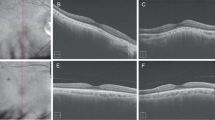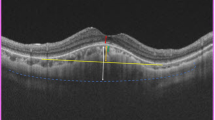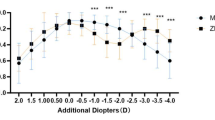Abstract
Purpose
To study the characteristic morphology and quantitatively evaluate the eye shape in different types of myopic maculopathy.
Methods
A total of 103 eyes from 65 patients with high myopic maculopathy were examined by spectral-domain optical coherence tomography (SD-OCT) and three-dimensional magnetic resonance imaging (3D MRI). The participants were classified into two groups, namely myopic traction maculopathy (MTM) eyes and non-MTM eyes, with SD-OCT imaging. Volume renderings and morphology analysis of the 3D MRI of the eyeball were obtained. Quantitative analysis was achieved in the calculation of vitreous volume and the three-dimensional diameters of the eyeball in three cardinal axes. The eye shape distribution and the diameters of the eyeball were compared between the two groups. Eye shape distribution, vitreous volume, and eyeball diameter were compared between MTM and non-MTM eyes.
Results
The MTM and non-MTM groups had a total of 68 and 35 eyes, respectively. A significant difference was found in the eye shape distribution (P<0.0001) between MTM and non-MTM eyes. Most of the MTM eyes had undergone a non-uniform expansion of the eyeball, whereas the non-MTM eyes had expanded uniformly. There was no significant difference (P>0.05) in either vitreous volume or other diameters between the two groups.
Conclusions
Non-uniform globe expansion and staphyloma formation might play an important role in the pathogenesis of MTM.
Similar content being viewed by others
Log in or create a free account to read this content
Gain free access to this article, as well as selected content from this journal and more on nature.com
or
References
Verkicharla PK, Ohno-Matsui K, Saw SM . Current and predicted demographics of high myopia and an update of its associated pathological changes. Ophthalmic Physiol Opt 2015; 35 (5): 465–475.
Curtin BJ, Karlin DB . Axial length measurements and fundus changes of the myopic eye. Am J Ophthalmol 1971; 71 (1): 42–53.
Ohno-Matsui K, Kawasaki R, Jonas JB, Cheung CM, Saw SM, Verhoeven VJ et al. International photographic classification and grading system for myopic maculopathy. Am J Ophthalmol 2015; 159 (5): 877–83 e7.
Panozzo G, Mercanti A . Optical coherence tomography findings in myopic traction maculopathy. Arch Ophthalmol 2004; 122 (10): 1455–1460.
Wakazono T, Yamashiro K, Miyake M, Nakanishi H, Oishi A, Ooto S et al. Association between eye shape and myopic traction maculopathy in high myopia. Ophthalmology 2016; 123 (4): 919–921.
Moriyama M, Ohno-Matsui K, Hayashi K, Shimada N, Yoshida T, Tokoro T et al. Topographic analyses of shape of eyes with pathologic myopia by high-resolution three-dimensional magnetic resonance imaging. Ophthalmology 2011; 118 (8): 1626–1637.
Moriyama M, Ohno-Matsui K, Modegi T, Kondo J, Takahashi Y, Tomita M et al. Quantitative analyses of high-resolution 3D MR images of highly myopic eyes to determine their shapes. Invest Ophthalmol Vis Sci 2012; 53 (8): 4510–4518.
Spaide RF . Staphyloma: Part 1. In: Spaide RF, Ohno-Matsui K, Yannuzzi LA, eds. Pathologic Myopia. New York: Springer; 2013; 167–176.
Curtin BJ . The posterior staphyloma of pathologic myopia. Trans Am Ophthalmol Soc 1977; 75: 67–86.
Pruett RC . Complications associated with posterior staphyloma. Curr Opini Ophthalmol 1998; 9 (3): 16–22.
Steidl SM, Pruett RC . Macular complications associated with posterior staphyloma. Am J Ophthalmol 1997; 123 (2): 181–187.
Hsiang HW, Ohno-Matsui K, Shimada N, Hayashi K, Moriyama M, Yoshida T et al. Clinical characteristics of posterior staphyloma in eyes with pathologic myopia. Am J Ophthalmol 2008; 146 (1): 102–110.
Rahimy E, Beardsley RM, Gomez J, Hung C, Sarraf D . Grading of posterior staphyloma with spectral-domain optical coherence tomography and correlation with macular disease. Can J Ophthalmol 2013; 48 (6): 539–545.
BJ C . Ocular Findings and Complications. The Myopias: Basic Science and Clinical Management. Harper and Row: Philadelphia, PA, USA, 1985; pp 297–299.
Cheng HM, Singh OS, Kwong KK, Xiong J, Woods BT, Brady TJ . Shape of the myopic eye as seen with high-resolution magnetic resonance imaging. Optom Vis Sci 1992; 69 (9): 698–701.
Verkicharla PK, Mathur A, Mallen EA, Pope JM, Atchison DA . Eye shape and retinal shape, and their relation to peripheral refraction. Ophthalmic Physiol Opt 2012; 32 (3): 184–199.
Gonvers M, Machemer R . A new approach to treating retinal detachment with macular hole. Am J Ophthalmol 1982; 94 (4): 468–472.
Kanda S, Uemura A, Sakamoto Y, Kita H . Vitrectomy with internal limiting membrane peeling for macular retinoschisis and retinal detachment without macular hole in highly myopic eyes. Am J Ophthalmol 2003; 136 (1): 177–180.
Ikuno Y, Sayanagi K, Ohji M, Kamei M, Gomi F, Harino S et al. Vitrectomy and internal limiting membrane peeling for myopic foveoschisis. Am J Ophthalmol 2004; 137 (4): 719–724.
Panozzo G, Mercanti A . Vitrectomy for myopic traction maculopathy. Arch Ophthalmol 2007; 125 (6): 767–772.
Ripandelli G, Coppe AM, Fedeli R, Parisi V, D'Amico DJ, Stirpe M . Evaluation of primary surgical procedures for retinal detachment with macular hole in highly myopic eyes: a comparison [corrected] of vitrectomy versus posterior episcleral buckling surgery. Ophthalmology 2001; 108 (12): 2258–2264.
Theodossiadis GP, Sasoh M . Macular buckling for retinal detachment due to macular hole in highly myopic eyes with posterior staphyloma. Retina 2002; 22 (1): 129.
Theodossiadis GP, Theodossiadis PG . The macular buckling procedure in the treatment of retinal detachment in highly myopic eyes with macular hole and posterior staphyloma: mean follow-up of 15 years. Retina 2005; 25 (3): 285–289.
Liu B, Ma W, Li Y, Luo Y, Jin C, Liang X et al. Macular buckling using a three-armed silicone capsule for foveoschisis associated with high myopia. Retina 2016; 36 (10): 1919–1926.
Parolini B, Frisina R, Pinackatt S, Mete M . A new L-shaped design of macular buckle to support a posterior staphyloma in high myopia. Retina 2013; 33 (7): 1466–1470.
Parolini B, Frisina R, Pinackatt S, Gasparotti R, Gatti E, Baldi A et al. Indications and results of a new l-shaped macular buckle to support a posterior staphyloma in high myopia. Retina 2015; 35 (12): 2469–2482.
Acknowledgements
This work was supported by the General Program (81570862) of the National Natural Science Foundation of China (to LL) and the General Program (81371019) of the National Natural Science Foundation of China (to YL). The funding organizations had no role in the design or conduct of this research.
Author information
Authors and Affiliations
Corresponding authors
Ethics declarations
Competing interests
The authors declare no conflict of interest.
Rights and permissions
About this article
Cite this article
Yu, X., Ma, W., Liu, B. et al. Morphological analysis and quantitative evaluation of myopic maculopathy by three-dimensional magnetic resonance imaging. Eye 32, 782–787 (2018). https://doi.org/10.1038/eye.2017.263
Received:
Accepted:
Published:
Issue date:
DOI: https://doi.org/10.1038/eye.2017.263
This article is cited by
-
Human achromatic flickers and phosphenes thresholds under extremely low frequency electric stimulations
Scientific Reports (2025)
-
Natural course of myopic traction maculopathy and factors influencing progression and visual acuity
BMC Ophthalmology (2021)



